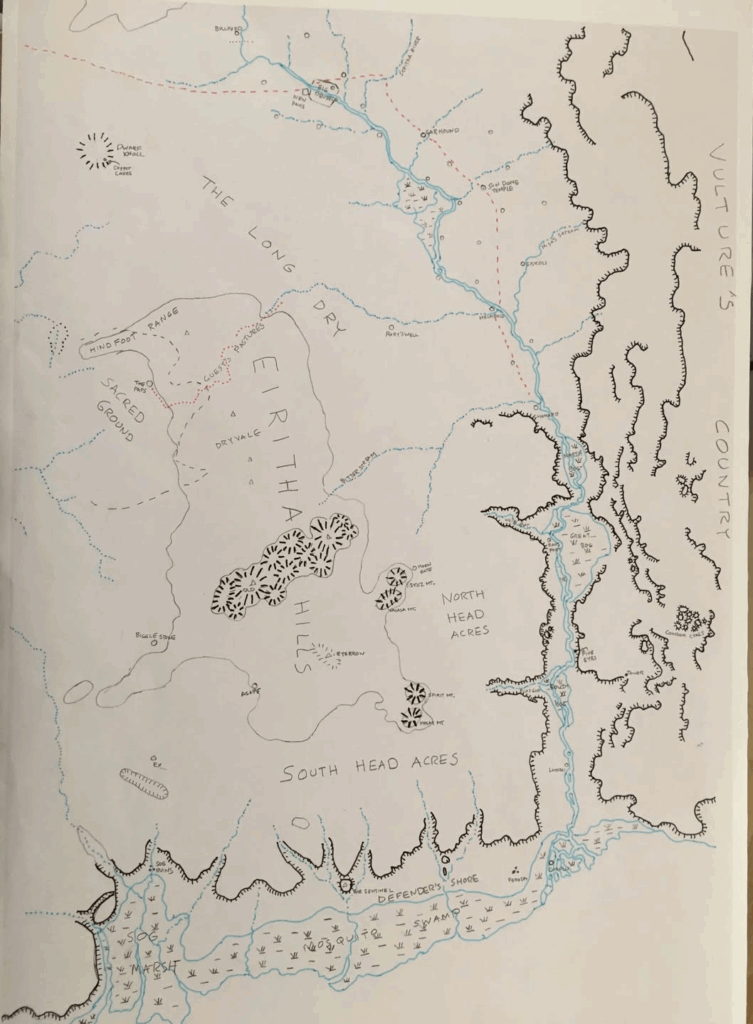To the south of Sun County are the former Grantlands, a series of seven colonial settlements established by the Lunar Empire in the remote frontier region beyond the arid plains of Prax, approximately 500 km from the nearest Lunar city, Furthest, across the rugged hills and mountains of Dragon Pass. Founded between 1615 and 1621, some 4,000 settlers made their way from Furthest to the Grantlands by late 1621, comprising refugees, adventurers, and retired Lunar veterans. The Grantlands were initially intended to produce agricultural exports and reward exiled Lunar noblemen. The most prominent, Weis Domain, was established in 1615 by Duke Raus of Rone at the confluence of the Zola Fel and the Vilinar stream, featuring the fortified Raus Fort (Ronegarth), a Mostali-built villa, and fertile bottomland farms.
The Grantlands now face significant challenges due to their isolation and the hostile environment. The long overland journey through restive nomadic tribes and rebellious territories limited imperial support, and by 1622, the Lunar Empire’s focus shifted to wars and rebellions elsewhere. The loss of Prax and Pavis in 1624 and Sartar in 1625 completely cut off the settlements, exacerbating raids by local tribes and resource shortages. The deaths of Duke Raus and other exiled officers in 1624 further destabilized the region, with Raus’s daughter Jezra assuming leadership of Weis Domain. By late 1625, Raus Fort became a refuge for approximately 300–400 Lunar survivors, boosting its population to around 1,500, while other settlements struggled or collapsed.
By late 1625, the Grantlands’ estimated 2,750 settlers faced a precarious future. Weis Domain remained the most resilient, supported by its fortifications, veteran militia, and fertile lands, though strained by refugees. A second large settlement at Red Cliff Domain, dwindled to around 350 settlers, while the rice plantation at Lokazzi Grant, crippled by the collapse of trade, held about 450, primarily slaves. The four smaller settlements, with roughly 275 settlers total, were on the brink of collapse, with survivors fleeing to Weis Domain.

See also
![]()
![]()
So, Raus is dead. A high price for his family political gambit in Oraya. He got to live another decade, outlived his wife, his bodyguard, and establish a colony that just might outlive him. Not bad actually. Compare that to the rest of his clan that got executed.
Something really important to think about the Grantlands is that it is some 500 km from Furthest to the Grantlands, and that trek is over rugged country and arid plains. The total amount of 4,000 settlers assumed that this was something that got a lot of support from the Provincial Administration and even the Red Emperor.
After 1621, that support was gone. And four years later, the settlement is in an existential crisis. The real question is whether the Grantlands can survive in a new form, or whether they are like the Roanoke Colony.
The Grantlands are in many ways similar to such historical colonisation schemes as Santa Elena (1566–1587), Roanoke (1585–1590), Popham (1607–1608), the Natchez Settlements (1716–1729), Presidio Los Adaes (1721–1773), Fort Pitt (1750s–1780s), and the Arkansas River Valley (1840–1870). Some of these survived. Others vanished completely.
From an imperial perspective, the Grantlands were a failure. They were more expensive to set up and maintain than moving the population to the Redlands, and the economic ventures like the Lokazzi rice farmers were pretty much a flop. After 1622, the new governor of Prax lost interest.
Did It cost imperial money to maintain the grantlands? Soldiers that patrol the river valley aren’t cheap. Nor are the caravans that brought the settlers. Nor were the slaves and crafters and wood and stone. Maybe Raus paid for that but that’s not going to last long then.
